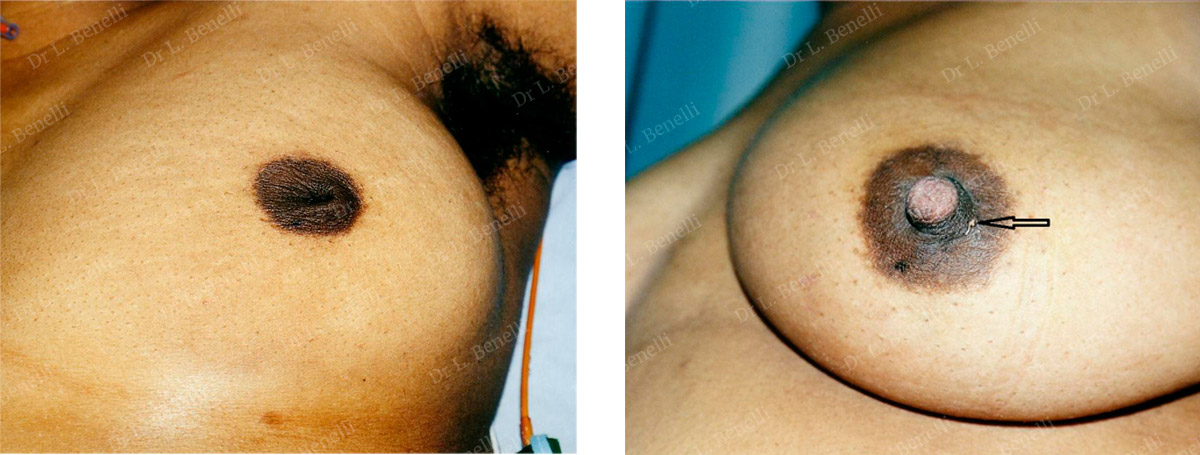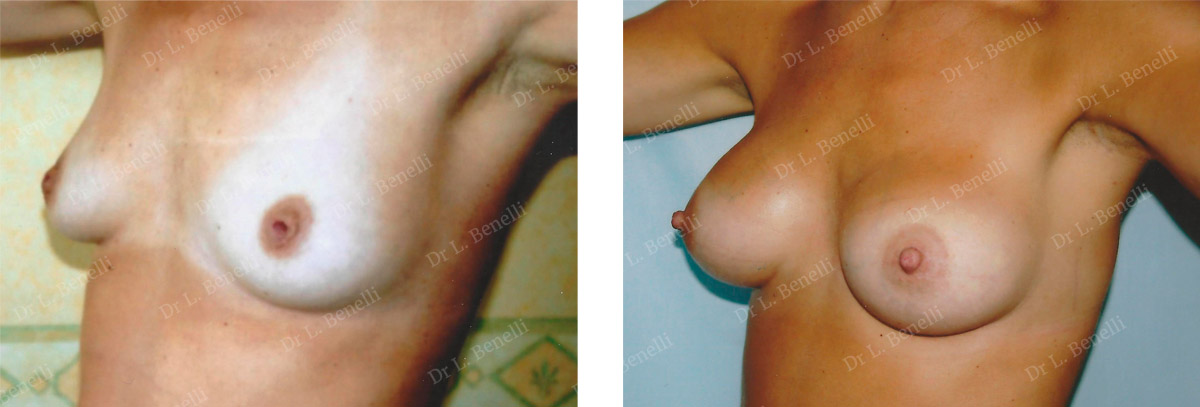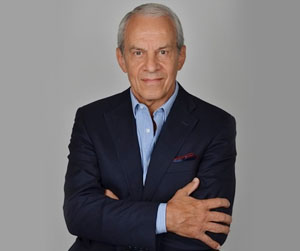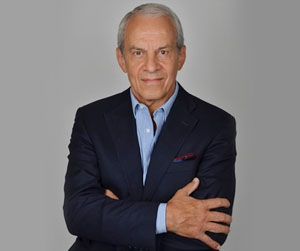Treatment of inverted nipples
Inverted nipples are a congenital malformation that appears at puberty during breast development.
This malformation is when there is a defect in projection of the nipple at the top of the areola and breast and nipple is retained inside the areola by cording, which anchor it down and prevent it from externalising.
This anomaly can be single or bilateral and more or less pronounced on one side compared to the other.
There are different grades of severity in terms of nipple inversion:
-
The least severe grade is the split nipple, which is partially retained inside but can be externalised by manual traction to extract it.
-
A more advanced grade of inversion is a completely buried nipple. It can be felt deep under the areola but cannot be externalised by a manual operation.

Inverted nipple. Result after 1 year
In addition to causing aesthetic problems, this malformation will lead to functional issues:
-
Hygiene problems due to the maceration of sebaceous secretions of the nipple which are retained inside the inversion and cannot be cleaned, which is a potential source of local infection.
-
Discomfort during intimacy, the nipple and areola being part of one’s erogenous zones.
-
Problems during breastfeeding: an infant cannot access a buried nipple, the milk will macerate inside the inversion, which is a potential source of inflammation or local infection.
The correction of this malformation is very simple when techniques are used to cut the mammary ducts that hold the nipple deep down, allowing it to be completely released. This leaves a very discreet 2mm scar at the base of the nipple. However, these techniques have the disadvantage of potentially preventing breastfeeding in future pregnancies.

Inverted nipple. Corrected with a 2mm scar at the base of the nipple
There are also techniques that preserve the ability to breastfeed but these require a more visible scar and carry a risk of the inversion recurring in the long term.
Uses
People suffering from this condition are not always informed of the opportunity to completely correct it with a very simple operation, virtually without scarring and under local anaesthetic. For this reason, they sometimes leave it a long time before seeking a consultation, even though they have been troubled with this for several years, particularly if there is a local inflammatory or infectious complication.
On the other hand, an adolescent who is experiencing aesthetic discomfort will have to wait until puberty is completely over and the breast has been stable for more than a year.
Often, patients who come for another breast operation, such as a breast augmentation, breast reduction or a breast lift will ask for this problem to be corrected at the same time.

Inverted nipples. Result after 1 year after using prostheses by the axillary route
Consultation
During the first consultation, it is essential that you express freely what bothers you and what you expect to improve. Do not be afraid to expose all your questions, fears and expectations. Everyone is different in morphology, psychology, expectations are not the same, there is no standard.
After you have explained your motivations, I will examine you and offer one or more solutions, taking into account your expectations, your anatomy, respecting your identity and the harmony of your physique.
During the first consultation, I will evaluate the technique I will use, favouring the choice of a technique that will preserve the ability to breastfeed if desired or limit the extent of the scar, according to your wishes.
In order for you to visualize the desired result, I will show you photos of surgical results from cases similar to yours to understand the objective of the intervention.
It is essential that you and I have a good understanding when deciding to operate and to determine the technique to use among from those I can offer.
I will then give you all the information on the techniques proposed along with the information sheets from the Société Française de Chirurgie Plastique Reconstructrice et Esthétique (French Society of Plastic, Reconstructive and Cosmetic Surgery) as well as a detailed estimate of the costs for the options chosen. You will then be able to move your project forwards and get ready for a second consultation when you will be able to ask any additional questions to help you make a decision and prepare for the operation.
Before the procedure
Pre-operative examinations should be performed:
-
Breast ultrasound and/or mammography to check breast health. These will allow any anomalies to be picked up and these may be treated during the operation or may possibly lead to additional pre-operative examinations.
-
A blood test, if necessary, depending on the type of anaesthesia (local or general).
In case of a general anaesthetic, you will need a consultation with the anaesthetist in the weeks preceding the operation and at least 48 hours before.
Recommendations:
No medications containing aspirin or anti-inflammatories can be taken within 10 days of the procedure.
For general anaesthetic, you will have to fast strictly for 6 hours before the operation (do not eat anything, chew gum, eat sweets or smoke).
Smoking can cause scarring problems.
The procedure
Hospitalisation and duration of the procedure:
In most cases, you will be able to leave the same day after a few hours of monitoring following the operation.
The procedure lasts about 30 minutes.
Type of anaesthetic:
Local, deep local (neuroleptanalgesia) or general according to your preferences.
Technique:
Before you go to the operating theatre, in your room, I will go over the precise goals with you as we agreed during the consultations. You can then always make recommendations and ask any questions. I will then draw the lines and marks on your skin to guide the operation and the lines of the incisions.
Two techniques can be used to correct inverted nipples:
1. The technique limiting the opportunities for subsequent breastfeeding, with reduced scarring:
The inverted nipple is hooked by a traction wire that holds it in a fully external position, a 2 mm incision is made at the base of the nipple to allow a complete section of all retracted mammary glands that hold the nipple in place. When this is complete, the nipple is released and will remain fully externalised.
A deep absorbable stitch is used to keep the nipple in an outwardly projecting.
2. The technique preserving the opportunity for subsequent breastfeeding, which has more extensive scarring:
The inverted nipple is secured by two traction wires which hold it in a fully external position and an incision is made between the two wires in the middle of the nipple and areola. This is vertical, running from top to bottom and parallel to the mammary glands, which are not treated to preserve breastfeeding ability. The two parts of the areola and nipple will then be supported by stitches, holding the nipple in an external position.
The stitches are absorbable and do not require removal.
At the end of the operation, a dressing is applied supporting a rigid plastic tube to keep the nipple in vertical position.
After the operation
During the night and the days following the operation, you may have a feeling of painful tension in the area of the operation, leading to impaired mobility. These pains are moderate in a resting position and may require analgesics. These post-operative pains will diminish and disappear within a few days after the operation.
The dressing can be completely removed during the first post-operative consultation, about a week after the operation. It will be replaced by an adhesive waterproof dressing, allowing you to take a showers. The dressing must be changed every 8 days.
As the stitches are absorbable, they do not need to be removed.
Swelling (oedema) and bruising around the areola are usually very moderate, it takes about ten days for them to disappear almost completely.
You will need to take about a day off work in the majority of the cases.
Care:
A waterproof dressing must be used for showering and will have to be changed every 8 days for a period of 1 month.
You will need to attend a follow-up consultation about a week after the procedure, then after 15 days, 1 month, 3 months, 6 months, and 1 year.
Recommendations:
-
Do not raise your arms too high and avoid heavy physical exertion.
-
You may resume sporting activities after 1 month following the operation, limiting yourself to painless movements.
-
The recommended rest position is lying on your back, slightly raised if possible. You may also lie on your side but must not lie on your front.
-
Exposure to the sun: no direct exposure for a month, then exposure is allowed using a sun protection cream with a maximum sun protection factor. No exposure as long as there are bruises or the scar is pink.
-
Pregnancy and breastfeeding: you should wait 6 months before considering a pregnancy so that the nipple has found its final shape and the mammary glands have had time to heal.
The result
The result is immediately visible despite any swelling and will improve in the weeks following the operation.
In the long term, the result will be stable and sustainable; recurrences are rare with the technique that cuts the mammary glands. With the technique that avoids this to preserve breastfeeding opportunities, there is a greater long-term risk of a recurrence of nipple inversion.
In addition to an aesthetic improvement, this operation has a beneficial impact on the patient’s personal well-being and development and they are relieved of their complex.
Risks and complications
Price range
The cost of the operation will depend on the procedure to be carried out, the duration of the operation, the type of anaesthetic and any hospital charges.
You may be covered by social security and, if applicable, by your mutual insurance company.
A detailed estimate is given to you during the first consultation according to the options chosen. You then have a minimum legal period of 15 days to reflect and take your project forward.
The first consultation costs €50. The following consultations, before and after the operation, are free.
The photographs on this page are here to illustrate and complete the information given on the operations. They are merely for information purposes so you can see the goals, results and scars from the operation.
The likelihood of scarring and each patient’s individual anatomy are different. Therefore, for this reason, the photographs on this site do not commit Dr. Benelli to providing all patients with a similar result.
The information given on a site is not sufficient in itself and a medical consultation is essential to get the right information for each individual case. For this, you’ll need to consult a surgeon qualified in Plastic Reconstructive and Aesthetic Surgery.



